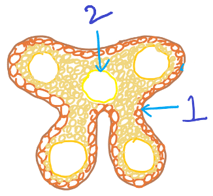This set of Class 12 Biology Chapter 2 Multiple Choice Questions & Answers (MCQs) focuses on “Reproduction in Flowering Plants – Structure of Microsporangium”.
1. What is young anther made up of?
a) Meristematic cells
b) Parenchyma
c) Pores
d) Seeds
View Answer
Explanation: Anther is the male reproductive structure in a flower. It consists of pollen sacs which contain the male gametes also known as pollen grains. Young anther is made up of homogeneous meristematic cells.
2. What are the meristematic cells in young anther, surrounded by?
a) Pores
b) Parenchyma
c) Meristematic tissue
d) Epidermis
View Answer
Explanation: The anther is made up of homogeneous meristematic tissues that are surrounded by epidermis. It then becomes 4 lobed. The archesporial cells are differentiated.
3. Label 1.

a) Edge
b) Filament
c) Stomium
d) Tapetum
View Answer
Explanation: When the pollen grains mature, the anther breaks open to release the pollen grains. This phenomenon is known as dehiscence. Stomium is the region of the anther where this phenomenon occurs.
4. Epidermis, Endothecium, Middle layers, Tapetum are ______
a) pollen sac layers
b) wall of anther
c) pollen grain layers
d) epidermal
View Answer
Explanation: The aforementioned parts form the wall of the anther. Epidermis forms the first layer. It surrounds the meristematic cells in young anthers. The second layer is the endothecium. Third layer is the middle layers and the innermost layer is the tapetum.
5. Label 2.

a) Vascular strands
b) Pollen sacs
c) Pollen grains
d) Meristematic cells
View Answer
Explanation: Vascular bundles constitute the xylem and phloem. Xylem transfer water and phloem transfers the nutrients from the root. It is important for the development of the anther and male gametes.
6. What are the 2 parts of the pollen sac?
a) Spongy and parenchyma cells
b) Outer wall and central tissue
c) Schlerenchyma and parenchyma cells
d) Outer wall and parenchyma cells
View Answer
Explanation: The microsporangium or the future pollen sac is a cylindrical sac like structure which consists of 2 parts. The outer wall and the central homogeneous sporogenous tissue.
7. How does the outer 3 layers help young anthers?
a) Osmosis
b) active transport
c) Nutrients and water
d) Protection
View Answer
Explanation: The outer three layers of the microsporangial wall (epidermis, endothecium, middle layers) help in protection of the young anther and mechanism of dehiscence in matured anthers.
8. Which two layers of the anther wall contain large cells?
a) Epidermis and Endothecium
b) Endothecium and Middle layers
c) Endothecium and Tapetum
d) Epidermis and Tapetum
View Answer
Explanation: The walls of the anther or microsporangium are present for protection in young anthers and for the mechanism of dehiscence in mature anthers. Endothecium and tapetum have larger cells compared to epidermis and middle layers.
9. What is the endothecium also called as?
a) Vascular strand
b) Fibrous layer
c) Middle layer
d) Hyperdermal layer
View Answer
Explanation: Endothecium forms the second layer in series of the microsporangial wall, that is between the epidermis and the middle layers. It has fibrous thickenings because of which it is also known as the fibrous layer.
10. What constitutes the stomium?
a) Pollen sacs
b) Hypodermal cells
c) Microsporangia
d) Meristematic cells
View Answer
Explanation: Stomium or the line of dehiscence constitutes the shallow groove present between the microsporangial sacs in the anther lobe. The hypodermal cells lying in that area of the endothecium are thin walled.
Sanfoundry Global Education & Learning Series – Biology – Class 12.
To practice all chapters and topics of class 12 Biology, here is complete set of 1000+ Multiple Choice Questions and Answers.
If you find a mistake in question / option / answer, kindly take a screenshot and email to [email protected]
- Check Class 12 - Biology Books
- Practice Class 12 - Chemistry MCQs
- Practice Class 12 - Mathematics MCQs
- Practice Class 11 - Biology MCQs
- Practice Class 12 - Physics MCQs
